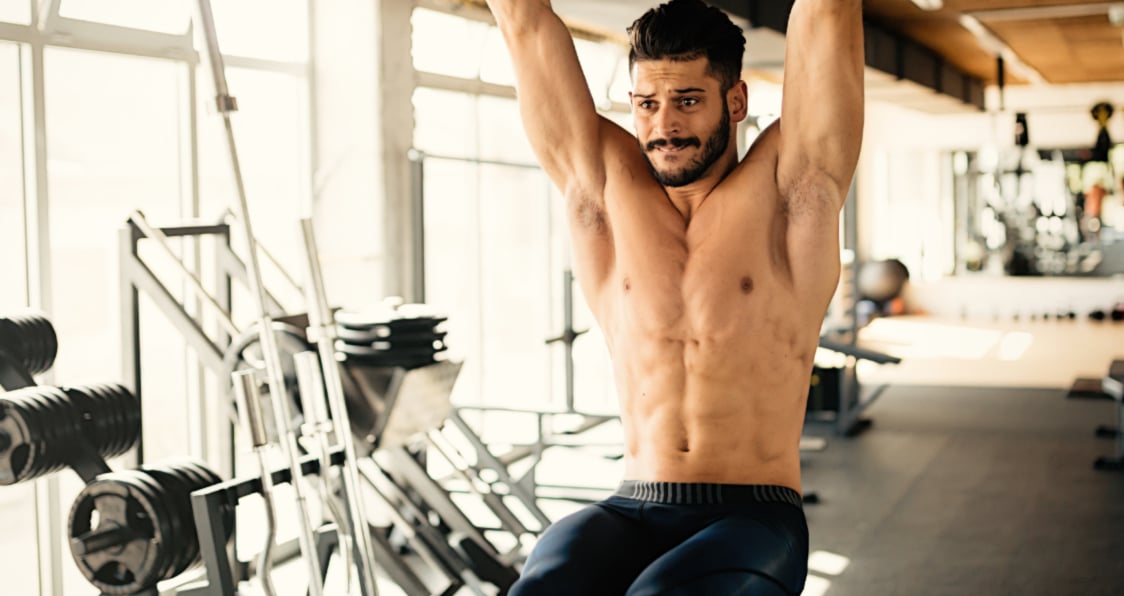Ab straps increase core activation while placing less stress on your back.
Engaging in core exercises is an excellent method of sculpting your abs, allowing you to proudly showcase a coveted six-pack physique and exude confidence when you shed your shirt. However, the benefits of developing strong core muscles extend beyond mere aesthetics. They contribute to maintaining impeccable form during fundamental bodybuilding exercises such as deadlifts and squats. Moreover, scientific studies substantiate that core stability exercises are the ultimate solution for alleviating lower back pain (1).
Athletes like bodybuilders can use kettlebells, dumbbells, or barbells to strengthen and train their core. However, doing this often comes with issues like a weak grip, sweaty palms, and a risk of slipping, depending on your chosen routines. In addition, most movements that target your core with weights only target your core as a secondary muscle group. All these could lead to less focus and effectiveness in your core exercises.
Ab straps support beginners and even experienced athletes doing core strengthening exercises. They’re great whether you train in a commercial gym or at home. This article explains what this equipment is and its many benefits.
What Are Ab Straps?
If you’ve witnessed CrossFit or strength athletes before, there’s a chance you’ve seen ab straps in use. They look like arm slings and loop over bars, allowing whoever uses them to exercise with their bodyweight suspended. All ab straps look and function similarly, but they come in different materials, secure to the bar differently, and have different levels of padding.
Benefits
Using them is a great way to sculpt your abs and offers support, allowing you to do many hanging exercises properly to maximize core activation. This study shows that they’re effective for training core muscles and even listed using ab straps as one of the best for building your abs and external obliques (2). Below are more benefits of ab straps.
Time Under Tension
They remove pressure from your arms and shoulders while supporting your elbows. This allows you to concentrate fully on training your core to build muscle and improve your definition. Using ab straps also prolongs your routines, putting your abs under tension for longer, leading to muscle hypertrophy (3).
Back Friendly
Most classic ab training routines like crunches and sit-ups can be painful for people with back pain. They allow you to train your core without disturbing your spine. Since you do most of these movements suspended, your back is also not under pressure.
Economical and Portable
They’re affordable; you can find decent pairs under $100. They also weigh nothing and can easily fit in your gym bag. This allows you to do your ab strap exercises anywhere, as the only other thing you need is a steady bar, rack, or post that is overhead.
Grip Strength
Grip strength is a necessity of many hanging ab training exercises, but with ab straps, you can bypass that rule. They also help to increase your range of motion and allow you to focus better, as you won’t be worried about slipping. Focusing increases your mind-muscle connection, which is key to effective muscle growth.
Activate Other Muscles
You can use ab straps to train your hip flexors with exercises like straight leg raises. Doing hanging shrugs also builds back muscles like your traps and lats. You can train more than just your abs with ab straps, creativity, and the right exercises.
Improve Strength and Stability
Ab straps help you target your core and strengthen your abdominal muscles. These muscles play a key role in your overall body strength and stability.
Comfort
Ab straps come with foam padding for your comfort when exercising. They’re also adjustable, so you can choose a length that works well for your body type. Choosing the right length is also important for keeping your neck and shoulders safe while exercising with these straps.
How to Choose The Best Ab Straps
A simple search online will show you many different types of ab straps. However, not all of them work for you, so it’s important to note their features to determine which will give the best value. Below are some important things to consider when choosing your ab straps.
Weight Capacity
Your ab strap needs to be able to carry your weight, especially if you’re a heavier athlete. You can find ab straps with a weight capacity range of 300 – 1500 lbs. Go for the ab strap that can carry the heaviest weight.
Length
People come in different heights and with different body morphologies. Your ab strap should be comfortable for you to train without stress. So, choose an adjustable strap that you can alter to fit snuggly for your exercises.
Comfort
When exercising with your ab straps, your hands will carry a lot of pressure, so it must be comfortable. Choose ab straps made of good material with padding that will support you. Remember that if you want more control over your workouts and feel your exercises more, your padding needs to be thinner.
Safety
The material of your ab straps should be able to keep you safe when suspended. So check that the carabiners that attach your straps to the suspending bar are high quality.
Conclusion
Ab straps are a great way to strengthen your core and sculpt your six-pack. For people with lower back pain, they offer a chance to train without putting too much pressure on your back. This fitness equipment is also affordable and convenient to carry around.
Consider weight capacity, length, and safety when choosing your ab straps. The straps that you choose should also offer comfort when doing your workouts. It’s time to stop dreading your ab training and get ab straps to fire up your core today!
Follow us on Instagram, Facebook, and Twitter for more fitness tips!
References
- Coulombe, B. J., Games, K. E., Neil, E. R., & Eberman, L. E. (2017). Core Stability Exercise Versus General Exercise for Chronic Low Back Pain. Journal of athletic training, 52(1), 71–72. https://doi.org/10.4085/1062-6050-51.11.16
- Escamilla, R. F., Babb, E., DeWitt, R., Jew, P., Kelleher, P., Burnham, T., Busch, J., D’Anna, K., Mowbray, R., & Imamura, R. T. (2006). Electromyographic analysis of traditional and nontraditional abdominal exercises: implications for rehabilitation and training. Physical therapy, 86(5), 656–671. https://doi.org/10.1093/ptj/86.5.656
- Mang, Z. A., Ducharme, J. B., Mermier, C., Kravitz, L., de Castro Magalhaes, F., & Amorim, F. (2022). Aerobic Adaptations to Resistance Training: The Role of Time under Tension. International journal of sports medicine, 43(10), 829–839. https://doi.org/10.1055/a-1664-8701










